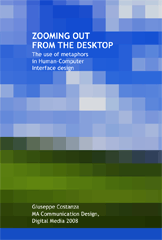Introduction
Humans and computers use very different languages for communicating. Human communication is rich, people use voice, writing, gestures, facial expressions. Computers work in a very different way, they are based on a simple binary code. When people and computers have to communicate with each other they need to find a point of contact, a common language that can be interpreted by both. The point where humans and computers meet is named Human-Computer Interface. An interface has to allow users to instruct computers and receive the produced results. Human-Computer Interfaces can have many different forms, today the most common interfaces are based on mouse and keyboard as input devices and screens as output devices. Human-Computer Interfaces should allow people to easily control computers expressing their will in a natural way, preventing errors and misunderstandings. The main issues concerning human-computer interface design are discussed in this dissertation. Common interfaces will be presented, as well as, possible alternatives to them.
The first chapter briefly exposes the history of human computer interfaces. In computer history processing speed has always increased, while prices have fallen down. This tendency allowed to employ an increasing amount of computing power in interfaces, making computer’s language easier for humans and shifting the communicational effort from people to computers. (Dourish 2001) The most important moment in human computer interface history is the introduction of graphical interfaces and the adoption of the desktop metaphor. The desktop metaphor was presented to the general public at the end of 1970s; (Moggridge 2007) it allowed students, office workers and businessmen to approach computers for the first time. The desktop metaphor perfectly suited users needs of that time.
Now, 30 years after the desktop metaphor introduction, the way people use computers is very different. Computers are used to play videogames, listen to music, watch movies, browse the web, communicate with other people; they are used at home on a table, on the sofa, on the bed, in cars. But our indispensable assistants are still communicating with us using the same desktop metaphor. In the first chapter it is pointed out that not much has happened in human computer interface history, since the introduction of the desktop metaphor. Most computer users experienced folders and file cabinets first as computer icons and later as real world tools to organize documents. This dissertation argues that the way computers organize information is constrained to concepts that are not up-to-date.
In the second chapter it is explained why the desktop metaphor was chosen. Some considerations, supported by authoritative points of view, about the use of metaphors in interface design are presented. Metaphors are powerful linguistic instruments used to compare something unknown to something known, but if used in a wrong way they can be misleading. At the end of the chapter it is illustrated the reasons why computer industry is anchored to the use of out-of-date concepts and metaphors.
The third chapter introduces some commercial and experimental interfaces aimed at improving or replacing the desktop metaphor. If the desktop metaphor is still in use it means that any alternative is good enough to replace the current paradigm. Then zooming interface paradigm is presented as an emerging alternative to the desktop metaphor. Zooming interfaces give users the possibility to easily control the level of displayed information, zooming on digital items as if they laid on an infinite plane. The zooming paradigm could mark a new big switch in human computer interface history. Also this chapter explains how zooming interfaces can better exploit the power of digital tools since they are less anchored to real world metaphors. Some zooming interface concepts already appears in current operating systems, but their full potentials have not been explored for the general use, yet.
In the last chapter, the One Laptop Per Child (OLPC) project is presented as a positive example of how interface design can take different routes. The OLPC project realized a laptop addressed at developing countries children. OLPC designers decided to realize an interface well suited for intended users, discarding the desktop metaphor and obsolete interface design conventions. OLPC interface is based on a zoom metaphor and it widely relies on spatialization as a universal concept understandable by different cultures.
Download the full text in pdf or order a printed copy
